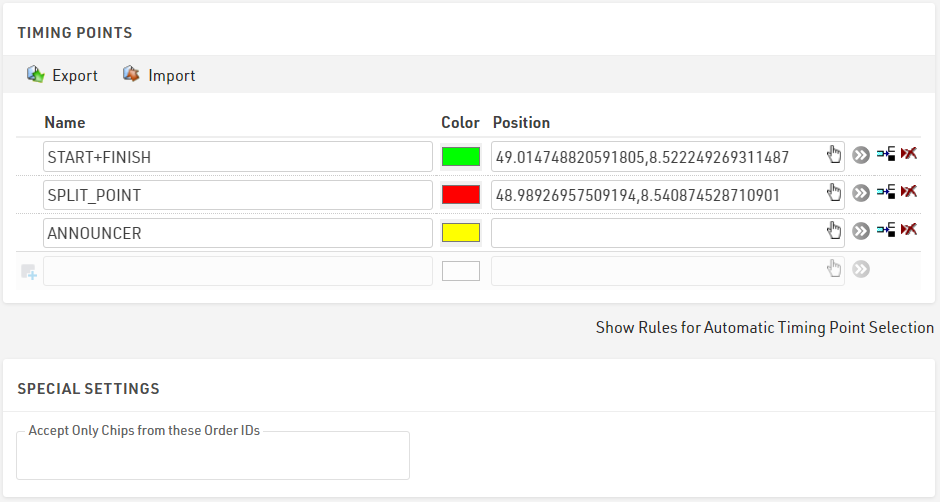A Timing Point is a location where one or more timing systems are placed. If you have a main and a backup line at a timing point, it is usally only one timing point unless you want to run statistics over the performance of main and backup.
Timing Points can be set up in Main Window->Timing Points.

Learn more about these settings in the sub-sections.
Timing Point Settings
Set the following parameters for a timing point:
Name
Convention in RACE RESULT 12 is to write these in UPPER CASE. The name should describe precisely what the timing point measures. It can be START, FINISH, START+FINISH, ANNOUNCER or 10K SPLIT. Sometimes, one timing point has different functions for different contests. Maybe you want to name it "M_10K HM_15K" if it is the 10K split for the marathon and the 15K split for the half marathon. It may also be "10K+30K" if it is a turning point course and the timing point will be passed after 10 and 30 kilometers.
Color
You can simply assign a color for the timing point. Timing data in RACE RESULT 12 will be marked accordingly.
Position
You can select a GPS position of that timing point. This is helpful later on to validate that the timing system is set up where it is supposed to be and is also used for some Tracking Visualisation platforms.
Timing Point Details
When clicking the  button, you can set more detailed parameters:
button, you can set more detailed parameters:
- Subtract Start Time (T0): The global setting (as part of Special Results) can be overridden. If needed, this can be set differently for individual timing points.
- Ignore Pre-Start Detections: The global setting (as part of Special Results) can be overridden. If needed, this can be set differently for individual timing points.
Automatic Timing Point Selection
Automatic Timing Point Selection can be configured in Main Window->Timing Points. It is especially important when working with Loop Boxes: Detections from different timing points (Loop Boxes) will be received through one timing system. That means you have to assign different timing points for different detections from one timing system.
On an event with several splits using the active system, we also recommend to use a unique channel and loop ID combination for each timing point, and to use the automatic timing point selection rules. This way, if a detection is stored on the transponder instead of being transmitted to the timing system on one split, it will be entered in the right timing point when the chip reaches the next timing system.
No matter which Timing Point is selected for a timing system, if one of the Automatic Timing Point Selection rules applies, then that Timing Point will be used. In most cases, you need to select only the Timing Point and the Loop ID.
If you choose to use the device ID as criteria, remember to include the letter prefix, for example D-4898 for a decoder, or T-20255 for a Track Box.

Special Settings
Accept Only Chips from these Order IDs: All passive bib transponders (except A-Z Tags) are encoded with the Order ID during production, this can also be seen in the raw data time RACE RESULT 12. Sometimes you may want to prevent old chips from being used, to filter to only to relevent Order(s) simply enter the Order ID here, multiple Order IDs can be entered separated by commas. This will apply dynamically and unrecognised chip reads will be ignored for results.